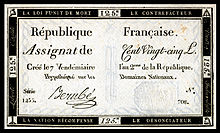French livre
This article needs additional citations for verification. (September 2014) |

The livre (abbreviation: £ or ₶.,[1] French for libra (pound)) was the currency of Kingdom of France and its predecessor states of Francia and West Francia from 781 to 1794. Several different livres existed, some concurrently. The livre was the name of coins and of units of account.
History
Origin and etymology
The livre was established by
.This first livre is known as the livre carolingienne. Only deniers were initially minted, but debasement led to larger denominations being issued. Different mints in different regions used different weights for the denier, leading to several distinct livres of different values.
"Livre" is a homonym of the French word for "book" (from the Latin word liber), the distinction being that the two have different genders. The monetary and weight unit is feminine, la/une livre, while "book" is masculine, le/un livre.
Late medieval and early modern period
| ₶ | |
|---|---|
Livre tournois | |
| In Unicode | U+20B6 ₶ LIVRE TOURNOIS SIGN |
For much of the Middle Ages, different duchies of France were semi-autonomous if not practically independent from the weak Capetian kings, and thus each minted its own currency. Charters would need to specify which region or mint was being used: "money of Paris" or "money of
.The currency minted at the city of Tours in Touraine was considered very stable, and Philip II decided to adopt the livre tournois as the standard currency of his lands, gradually replacing even the livre of Paris, and ultimately the currencies of all French-speaking areas he controlled. This was a slow process lasting many decades and not completed within Philip II's lifetime.
The result was that from 1200 onwards, following the beginning of King Philip II's campaigns against King John, the currency used within French speaking lands was in a state of flux, as the livre tournois was gradually introduced into other areas.
Until the thirteenth century and onwards, only deniers were actually minted as coin money. Both livres and sous did not actually exist as coins but were used only for accounting purposes.
Upon his return from the crusades in the 1250s,
Between 1360 and 1641, coins worth 1₶. were minted known as francs. This name persisted in common parlance for 1₶. but was not used on coins or paper money.
The official use of the livre tournois accounting unit in all contracts in France was legislated in 1549. However, in 1577, the livre tournois accounting unit was officially abolished and replaced by the
Seventeenth century
In 1667, the livre parisis was officially abolished. However, the sole remaining livre was still frequently referred to as the livre tournois until its demise.
Eighteenth century

The first French paper money was issued in 1701 and was denominated in livres tournois. However, the notes did not hold their value relative to silver due to massive over–production. The Banque Royale (the last issuer of these early notes) crashed in 1720, rendering the banknotes worthless (see John Law for more on this system).
In 1726, under
- the double Louis d'or (gold coin) of 48₶.
- the Louis d'or(gold coin) of 24₶.
- the demi-Louis d'or or half-Louis (gold coin) of 12₶.
- the écu(silver coin) of 6₶. or 120 sous, along with 1⁄2, 1⁄4 and 1⁄8 écu denominations valued at 60, 30 and 15 sous
- the sou (copper coin) denominated in 1 and 2 sou units valued at 1⁄20₶. (or 12 deniers) per sou
- the denier(copper coin) denominated in 3 and 6 denier units valued at 1⁄4 and 1⁄2 sou respectively (the three denier coin was also called a liard).
However a coin of 1₶. was not minted. Yet in 1720 a special coin minted in pure silver was produced and assigned a token value of 1₶. Additionally, France took Navarrese 20-sou coins minted in 1719 and 1720, re-struck them as 1⁄6 écu (between the years of 1720 and 1723) essentially creating a coin worth 1 livre. These re-struck coins, however, eventually were assigned the value of 18 sous.[2]

A kind of paper money was reintroduced by the
The last coins and notes of the livre currency system were issued in
Later history
The livre had also been used as the legal currency of the Channel Islands. The Jersey livre remained legal currency in Jersey until 1834 when dwindling supplies of no-longer minted coins obliged the adoption of the pound as legal tender.
Today and after two centuries of using the franc, France uses the euro as its currency.
References
- Encyclopédie ou Dictionnaire raisonné des sciences, des arts et des métiers(in French). Vol. 1. p. 37b–38a.
- ISBN 978-0-88968-348-8.
